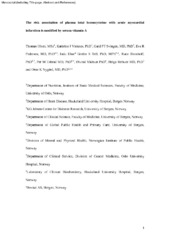The risk association of plasma total homocysteine with acute myocardial infarction is modified by serum vitamin A
Olsen, Thomas; Vinknes, Kathrine; Svingen, Gard Frodahl Tveitevåg; Pedersen, Eva Ringdal; Dhar, Indu; Tell, Grethe S.; Blomhoff, Rune; Ueland, Per Magne; Midttun, Øivind; Refsum, Helga; Nygård, Ottar
Peer reviewed, Journal article
Accepted version
Permanent lenke
https://hdl.handle.net/1956/19649Utgivelsesdato
2018Metadata
Vis full innførselSamlinger
Originalversjon
European Journal of Preventive Cardiology. 2018;25(15):1612-1620 https://doi.org/10.1177/2047487318788587Sammendrag
Background. Plasma total homocysteine (tHcy) has been implicated in the development of cardiovascular disease, but the mechanisms remain unclear. Vitamin A (Vit-A) is involved in homocysteine metabolism and we therefore explored the potential interaction between plasma tHcy and serum Vit-A in relation to incident acute myocardial infarction. Methods. Cox proportional hazards models were used to assess the prospective relationships between tHcy and acute myocardial infarction in 2205 patients from Western Norway undergoing elective coronary angiography for suspected stable angina pectoris. Results are reported as hazard ratio per standard deviation increase in log-transformed tHcy. An interaction term for tHcy × Vit-A was added to multivariate models including age, sex, smoking, apolipoprotein B fasting, statin and aspirin prescription and estimated glomerular filtration rate. Results. Geometric mean (geometric standard deviation) age of the participants (64.3% men) was 62.3 (1.24) years. Plasma tHcy was higher among participants in the upper versus lower Vit-A tertile. During 7 (2.4) years of follow-up, 15.1% suffered an AMI. A significant association of plasma tHcy with AMI in the total study population was observed. When we stratified the population according to Vit-A tertiles, plasma tHcy was associated with acute myocardial infarction only in the upper Vit-A tertile (hazard ratio per SD: 1.25, 95% confidence interval: 1.04–1.53, pinteraction = 0.03). Conclusions. The risk relationship between plasma tHcy and acute myocardial infarction was modified by serum concentrations of Vit-A in patients with suspected stable angina pectoris. This finding may clarify the relationship between tHcy and cardiovascular disease.
